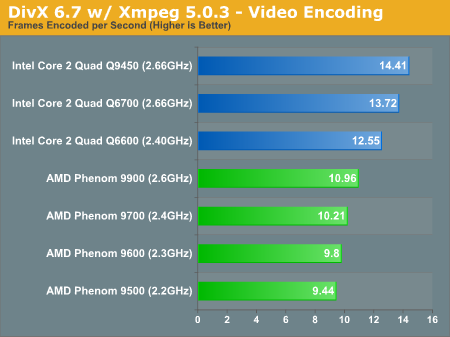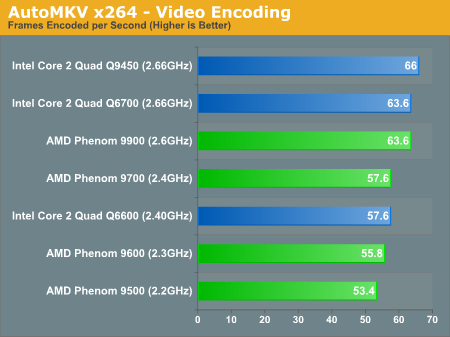AMD's Phenom Unveiled: A Somber Farewell to K8
by Anand Lal Shimpi on November 19, 2007 1:25 AM EST- Posted in
- CPUs
Media Encoding Performance
We'll start with our DivX test; this is the same benchmark we've been running for years, we've simply updated to DivX 6.7. The codec was set to Unconstrained quality, with the quality/performance slider at 5 and enhanced multi-threading enabled. The rest of the codec settings remained at their defaults.

Despite the move to four cores and the improvements to the K8 architecture, the Phenom, even at 2.4GHz, is slower than the Core 2 Quad Q6600. Clock for clock, Intel has a 24% performance advantage here.
AMD did make some progress however, if we look back at some of our older numbers the gap at 3.0GHz between dual-core chips was almost 38%.
The situation gets even more bleak once you take into account that the Phenom 9700 will most likely ship when Intel's Q9450 is also available which extends Intel's lead to over 30%.
AMD has always been much more competitive at encoding using Microsoft's Windows Media Video codec:

Windows Media Encoder performance is virtually identical between the Phenom and Core 2 Quad at the same clock speed. However, once you take price into account, Intel starts to pull ahead; the Q6600 is priced competitively with the Phenom 9600 and manages a 7% performance advantage over the 9600. It's not much, but the Q6600 is also cheaper.
Our final encoding test is an increasingly popular format: x264. We encode the same .avi file from our WME test but this time using the x264 codec and AutoMKV. We didn't encode audio and left all program settings at its defaults, the only thing we changed was we asked that the final file size be 100MB (down from 500MB).

Much like our WME results, clock for clock AMD's Phenom actually equals the performance of the Core 2 Quad. Take price into account and Intel is still the right buy; it's tough to say what will happen when the Phenom 9700 and 9900 eventually launch because they may be competing against Penryn at that time, which in this case would be the Q9450, a more formidable opponent.










124 Comments
View All Comments
Hellrazor0628 - Thursday, January 3, 2008 - link
Well I think that intel got the processing but i realy dont think at the first place that the phenom is ready they need time and money to be able to get rev. in good working and debuged intel had that money and time they realy took their time befor shoing up with core2 wonld say tow years almost. Amd had already a small part of the market enven whene they give the best performance for the price even compaired to the best intel. To say it I realy was hoping the truth native quad core phenom would be better proccesing too but in ther other hand there are a lot of technogie that need to be looking at about amd that poeple sould take a look at about the phenom that is key to all amd cpu that people are too stupid to look at and understand. like power comp. wtf man there is a bus and a memory controler my nvidie chip set coul burn and egg and it only have to run the pci and pci-x.hoelder - Wednesday, December 12, 2007 - link
I remember to have to save food of my mouth to buy the first ill conceived Pentium or the 486. How Intel set those prices evades me. They maximized their profits with no competition. Yes I know Intel produces a faster chip, if faster is the right word. However, when it comes down to competition and the markets, AMD is the strategically right choice. Unless of course you think that the Walmart buy cheap toys from China idea is your consumer ideology then you should stick with Intel, that actually is going like Nixon to China or you believe in the consumer choices should keep competition open.mpholland - Friday, November 30, 2007 - link
Maybe AMD just had to release these early to make a little capital this year. Personally I think that it is good that AMD let people know SOMETHING is close. I am hoping that with a little tweaking AMD and some MB partners can get performance up a little and be competitive with Intel sometime in 2008. I have seen just simple driver tweaks work wonders on other hardware, maybe just a little more time can help.Clauzii - Thursday, November 22, 2007 - link
--Clauzii - Thursday, November 22, 2007 - link
By reading through the benchmarks, where a single core (of a quad) is compared to all four cores running, it looks like the 8 core version of the "Phenom" would scale even better than the four-core one. The Barcelona btw. also shows this behavior, by having one core being just a little faster than the Opteron core, but the four running in tandem scales very well.Because of the not-so-good MHz numbers, it might not take AMD to new glorious heights for now, but when (soon?) 8 cores arive, AMD MIGHT be able to do better, because of their better core-scaling factor.
Looks like they HAVE to do something like gluing together two Phenoms to at least do 8-cores before intel, and before intel gets TOO fast for AMDs liking and the ability to catch up slips away.
Unless AMD already is working on a true 8-core design, which would probably scale even better than a glued one. And by incooperating knowledge on multithreading from ATIs designing of GPUs they might be able to do something even more serious in the future.
But for know, intel is still in the lead.
praeses - Thursday, November 22, 2007 - link
I really wish that AMD never went down the road of L3 cache for these processors. As the majority of applications still used today in the desktop/workstation market are going to be only one or two cores, the shared cache itself probably causes more of a hindrance.Personally I would have liked to see 128k L1 and 1MB of L2 for the higher models, and simply the 512K L2 for the lower models. The tweaks to the individual cores would almost enable them to catch up clock per clock with Intel without this L3 cache latency getting in the way, and that way powering down the individual cores would also power down all the cache they would be using as well. I realize that routing the L2 cache in larger quantities is trickier and consumes more die space than L3 but they should also be able to gain significantly cost measures in those produced without L3 and be able to compete better in the $180 or so market.
Granted if a single application was single threaded and the only one taxing the system while taking advantage of all the L3 at once, and the other 3 cores were sleeping, it would be a slight disadvatage, but that's an extreme situation.
WorkIsAFullTimeHobby - Thursday, November 22, 2007 - link
I think Anandtech power consumption graphs are way off. Phenom power consumption sould be compared to Penryn power consumption plus NSB power consumption. Does any body see any mention of this fact and do the graphs properly account for this?Phenom effectively has the north side memory controller bus built in. After looking at the Architecture now I know why Intel is always trying to increase MB bus speed. They only have one external bus to feed and comminicate between all the CPU's.
redzo - Wednesday, November 21, 2007 - link
After all of this being said i have only a few words for you:- AMD's faith it's in the hands of its ability to cut down the prices even more.
- Cheaper by 13% it is just not enough ! ! ! unless they cut down the prices even more they'll loose more customers!
- Of course that they can trust in their marketing strategy( true quad core ), but not for long: It's PERFORMANCE and PRICE/PERFORMANCE that matters and not STYLE or FASHION.
jwizmo - Wednesday, November 21, 2007 - link
One thing to keep in mind here is that the Quad-Core AMD chip is a 64-Bit part, like it's predecessor. To perform these tests without giving it a chance in 64-Bit mode is not a fair comparison. I would like to see some subset of these same tests with Windows Vista Ultimate 64-Bit. The drivers should be out there for that configuration. Let's see how it performs in that mode, I don't think there will be much competition from Intel then. When everything finally goes 64-Bit AMD will have the advantage, since they got in at the ground floor.newuser2 - Wednesday, November 21, 2007 - link
I was checking holidays buyers guide and then I noticed that in the tests you were using for intel a motherboard that costs $335 and DDR3 memory which is $580 (I think I must be wrong here), while for AMD you used a $180 board and DDR2 memory for $121. That would be comparing a $915 platform vs $301 one, am I correct? Don't misunderstand me, I just think I didn't understand what you used to test what.